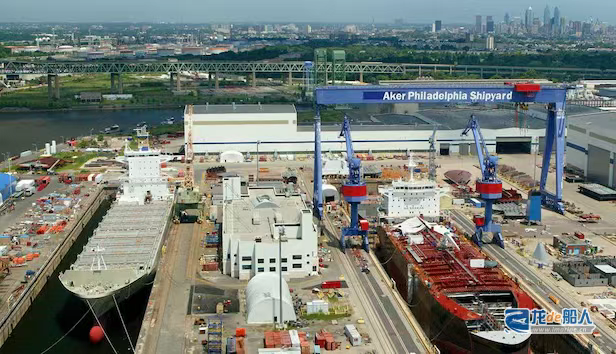Hanwha Ocean is advancing a rotation program for employees of Hanwha Philly Shipyard (formerly Philly Shipyard) to South Korea. The initiative aims to enable employees of Hanwha Philadelphia Shipyard to accumulate experience in high-value-added shipbuilding, strengthen Philly capabilities, and thus enter the field of liquefied natural gas (LNG) carrier construction.

According to Korean media reports, more than 50 Korean experts have come to the United States to impart their technical and process experience. Hanwha Ocean is promoting a rotation plan for Hanwha Philly Shipyard employees to Korea for up to one year. The purpose of this rotation is to allow Hanwha Philly Shipyard employees to experience and learn about Korean shipyards’ dock schedule management and modular processes.
Philly Shipyard was established in 1997. It was formerly the Philadelphia National Shipyard of the U.S. Navy. It covers an area of 480,000 square meters and has the largest dock in the United States. It specializes in building commercial ships for coastal transportation. At the end of 2024, Hanwha Group completed the acquisition of Philly Shipyard for approximately US$100 million and renamed it Hanwha Philly Shipyard. As one of the important shipyards in the United States, about 50% of the large commercial ships in the United States that comply with the Jones Act come from Hanwha Philly Shipyard.
It is reported that Hanwha Philly Shipyard has made almost no investment since its establishment. In order to improve its shipbuilding capabilities, HanwhaOcean is introducing a smart shipyard system for the shipyard. The system digitizes the information of ship parts and uses the Global Positioning System (GPS) installed on the parts to enable the central control room to monitor the progress of operations in real time. It will also expand the application of robot technology such as automatic welding and equip equipment for painting training using augmented reality (VR) technology to improve the skills of employees.
Last month, Hanwha Ocean announced that it would invest $72 million to upgrade the Hanwha Philly Shipyard to a high-tech shipyard, increasing its annual production capacity from the current 1.5 ships to a maximum of 10 ships by 2035, an increase of about 7 times the current level. The investment will be used to upgrade the dock and automate the shipbuilding process. In addition to the previous production of oil tankers and container ships, it also plans to build LNG carriers, making it the first shipyard in the United States to build LNG carriers.
At present, the Philly Shipyard primarily operates Dry Docks 4 and 5, which are used for shipbuilding and mooring, respectively. Hanwha Ocean plans to restore the production capacity of Dock 5 and increase the annual production capacity of Docks 4 and 5 to 3 to 4 ships, bringing the total annual production capacity to 8 to 10 ships. Additionally, Hanwha Ocean aims to double the current workforce at the Hanwha Philly Shipyard by 2035, increasing it from 1,500 to 3,000 employees.
David Kim, CEO of Hanwha Philly Shipyard, previously said: “The company is considering building other types of high-value-added ships under the Jones Act. We are currently exploring opportunities related to LNG carriers and believe that there is an opportunity to establish a new industry centered on LNG carrier construction in the United States.”
Since US President Trump took office, the US has been actively promoting the expansion of LNG exports. Clarkson predicts that by 2029, global demand for LNG carriers will reach 126 ships, with a total market size of 40 trillion won.


